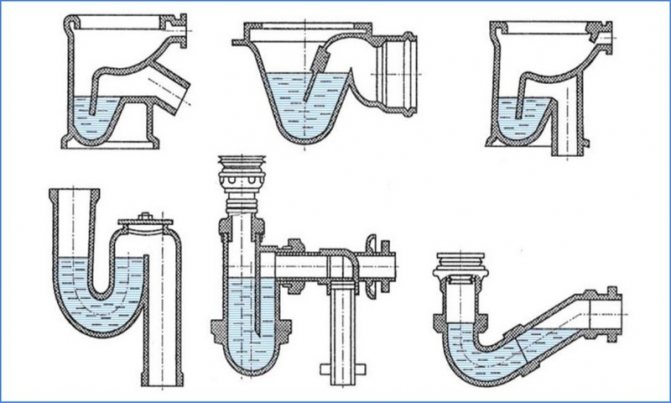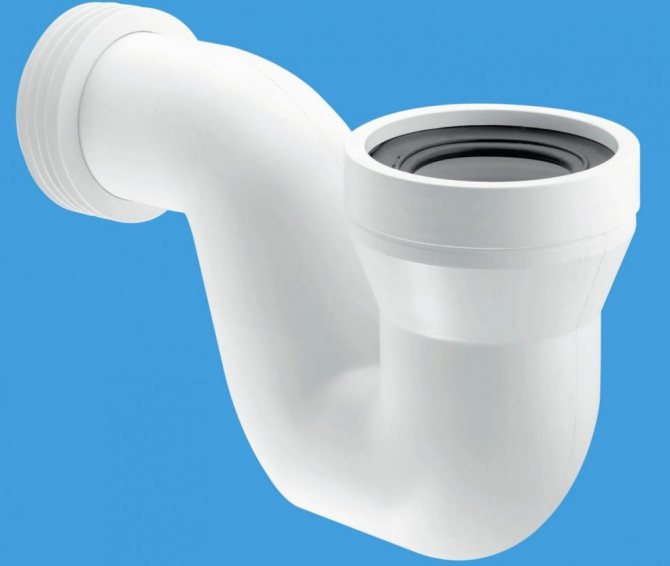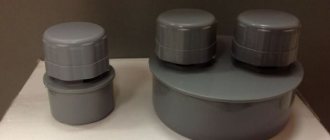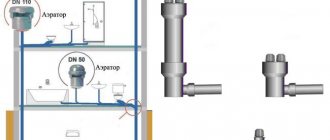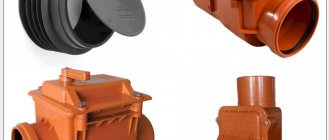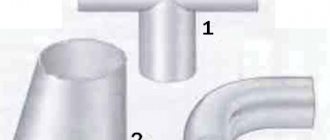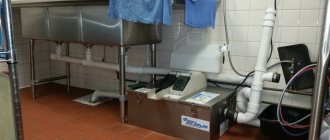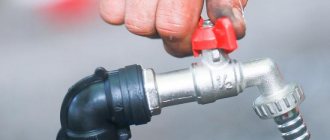Sewer trap is an indispensable element of plumbing equipment. It serves to prevent strong unpleasant odors from entering the room from the drainage system. What is the principle of operation of the device, what are the types of hydraulic valves, how to choose the right product and install it? All answers are contained in this article.
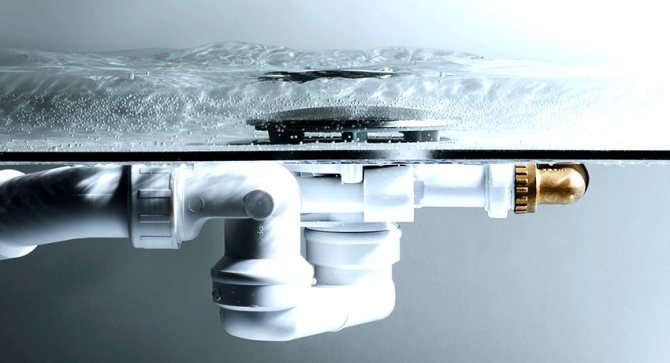
The sewer odor trap is used to prevent the penetration of unpleasant odors into the room from the drainage system
Water trap: this is a must-have element of plumbing equipment
The first step is to figure out what a shutter is. The element is represented by a pipe with bends, which has a certain shape. It can be additionally equipped with dynamic or dead-end devices. In the lower elbow of the siphon, there is a permanently located water plug, which, if the system is not used for a long time, can evaporate, which will lead to the penetration of unpleasant odors from the sewer network into the room.


For the correct operation of the water seal, there must always be water in its cavity
With the active operation of plumbing equipment, the fluid supply is constantly updated, successfully containing foul-smelling substances. When draining, wastewater flows freely through the siphon, which eliminates the likelihood of clogging the system.
Important! For the correct functioning of the hydraulic seal, a certain volume of water must be located in its cavity, which is necessary to prevent gas backflow and unpleasant odors.
What is a water seal for? The siphon blocks hydraulic shocks, which significantly reduces the load on sewer pipes and devices. It also protects living quarters from the penetration of unpleasant odors from the drainage system.
A water seal is rarely found inside a particular plumbing device, such as a toilet or urinal. Mostly it is mounted to the fixture. The residential building does not have a washbasin, bathtub, shower cubicle or toilet without a water seal.


The hydraulic seal can be inside the plumbing device, but mostly it is mounted separately
Varieties of drainage structures for a shower
There is a wide variety of varieties of floor shower drains of this type. Shower traps may differ in shape, design, size (height), and in materials of manufacture. Regarding the shape of the lattices, they can be rectangular, square or round.
And by design, there are wall, point and linear fixtures. Linear structures are usually installed in the corner or at the edge of the shower room. Point ladders can be located anywhere on the floor under the tiles, Well, wall devices are mounted mainly at one of the walls. Ladders are also distinguished by the type of outlet: horizontal or vertical. It depends on its location in which direction the sewer pipe will be connected to the drain.
As a rule, in the design of most ladders, an ordinary water seal is provided, located in the siphon. But such a device has one significant drawback - if you do not use the shower for a long time, then the water inside evaporates, and unpleasant odors penetrate into the bathroom. In this case, it is better to choose a shower trap with a dry closure.
Designs with a dry seal completely isolate the premises from the penetration of odors from the sewage system, since in this device, in addition to the water seal, there are several more dampers that block the channel under its own weight. When water enters the drain channel, these dampers open, allowing liquid to pass through unhindered, and then close again.
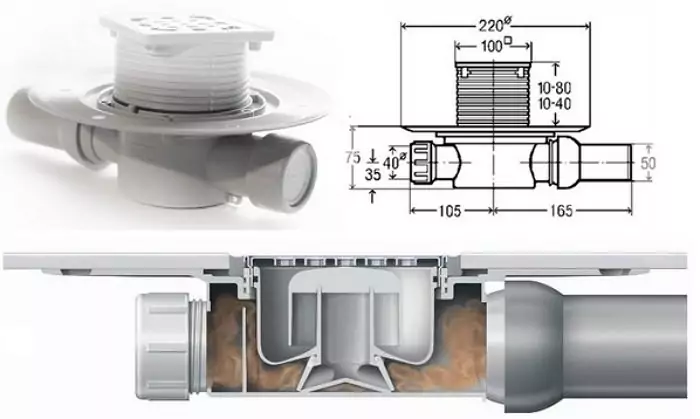

The drain in the tiled floor of the shower room is installed in the most convenient place for this. The main thing is that the drain is located at the lowest point of the bathroom, ensuring effective collection of the flowing liquid. So, the drain hole can be installed in the following places:
- In the center of the shower stall or with a slight offset to one side. Standard version of the location of the drain. In this case, it is necessary to ensure the appropriate slope of the floor from the four walls.
- Near the wall. In this case, the slope of the floor is made from one of the walls towards the drain hole. As a rule, slotted drains with high throughput are arranged in this way, since such devices are less likely to clog.
- In the corner. This type of drain hole looks great on the floor without being conspicuous. In this case, the slope of the floor surface is made in two planes to the desired angle, ensuring the flow of water to a specific place.
It is worth noting that when choosing a shower drain, you must also pay attention to the height of the device. This parameter determines how much you need to raise the level of the floor covering at the drain hole
Of course, everyone wants the floor height to be as low as possible, but keep in mind that the higher the ladder height, the higher its throughput. Therefore, there is a special type of ladder with adjustable height, choosing it, you can adapt the device to any height of the screed.
Varieties of hydraulic valves, depending on the design
Depending on the design features, there are 6 types of hydraulic locks: elbow, bottle, double-turn, corrugated, dry and with an overflow system.
The elbow siphon with a water seal is easily recognizable by its appearance. Its design resembles the Latin letter U. The siphon is made of plastic or metal. The first option is presented by polypropylene products, which are characterized by reliability, simplicity and ease of installation. For the manufacture of metal siphons, cast iron or bronze is used. Today, such models are less common due to their high cost.
Plastic devices can be produced in a disposable design, they do not have the ability to adjust the position of the element. In case of failure, a complete dismantling of the product is carried out. Other models are made up of building blocks that can move and rotate to adjust the position of the nozzle. The parts are fixed by means of overhead plastic nuts and clamps.
The knee has two bends: inlet and outlet. The lower position of the second element is 5-6 cm below the first. More reliable and durable options are presented by the S-shaped design. Cleaning of the product is carried out using a special flexible cable with a brush at the end or by hand after disassembling the product.
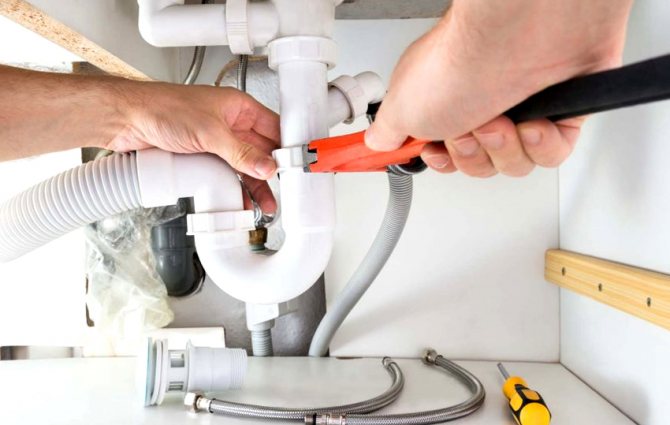

The elbowed water seal for the sewage system has a U- or S-shaped design
Such a water seal of the sewage system is characterized by its durability, which ensures a free and easy installation of the system without fear of damage to it. Elbow siphons are mainly installed on sinks, bathtubs and toilets. There are models equipped with an additional outlet, which makes it possible to simultaneously use a water seal for the washing machine.
Distinctive features of hydraulic bottle seals
Bottle fixtures are most often installed in kitchens under sinks. To understand how a water seal works, you should study its design. The product is designed in such a way that food waste particles are trapped, preventing clogging of the system in order to maintain its good performance. At the same time, such a shutter performs the main function, which is to keep unpleasant odors and eliminate the likelihood of them getting into the room.
The bottle odor trap consists of pipes and an additional bottle-shaped element, which is a kind of container for collecting food waste. This container is located below the level of the drain pipe, this provides free access to the element. The container includes a vertical drain pipe connected to the sink, from its side part there is a branch pipe for connection to the sewer network.
Bottle siphons are made of polypropylene, however, in terms of strength, they are inferior to knee counterparts. This is due to the fact that the connection of all elements may not withstand the strong pressure of water. However, the bottle siphon is most suitable for use in the kitchen. A positive point also lies in the lower price of a water seal for a 110 mm sewage system, which averages 250 rubles.


Due to its structure, the bottle odor trap is best suited for use in the kitchen
For normal operation of the device, it must be periodically cleaned, since the remains of food waste accumulate in the cavity of the container, preventing the free flow of drainage water. Remove the container to clean it. For this, the overhead nut is unscrewed, all the debris is shaken out of the container. Then you should thoroughly wash the inside of the container with detergents and hot water. After that, the device is installed in its original place. The nut is tightly tightened to prevent water leakage.
Important! Bottle odor traps are capable of trapping an object that accidentally falls into the drain.
What is a water seal for?
During fermentation, sugar is decomposed by yeast into water, alcohol and carbon dioxide, which is obtained in a sufficiently large amount (4 m³ for 1 liter of alcohol). The accumulation of gas in the tank leads to the formation of increased pressure, which must be disposed of. Carbon dioxide should be removed, but so that oxygen does not get to the fermentation products. At distilleries, the exhaust gas is collected and converted into carbon dioxide by increasing the pressure. At home, the gas is discharged into the air or a discharge device connected to the sewer. To prevent air from entering, special devices called water locks are used.
There is a long-standing debate about the need to use check valves. Some winemakers believe that mash should breathe. During the active phase of fermentation, the released carbon dioxide does not allow air to come into contact with the home brew and the process of alcohol oxidation into vinegar does not occur. It should be noted that the emitted gas is much heavier than air and always goes down. But as soon as the post-fermentation phase begins, the gas evolution process decreases and in the vessel without a water seal, the wash gains access to oxygen, as a result of which the process of processing alcohol into vinegar begins. As a result of the processing of oxidized mash, moonshine will get an unpleasant smell and taste, while the yield of alcohol-containing liquid will significantly decrease. Therefore, novice producers of home drinks should use devices that protect the contact of processed products with oxygen, leaving experiments with breathing mash to more experienced specialists.
What is a double-turn bathroom odor trap
A two-turn siphon is an analogue of a knee outlet, but it differs in a more complex water seal device. The drain pipe of the device is connected to the outlet of the plumbing equipment. In this place, an additional filter grate is installed to trap hair and animal hair. It smoothly turns into an elbow, which connects to another pipe, which is directed to the drain. The last element is located at a slight incline.
How to use the odor trap when cleaning it? For this, some models of double-turn siphons can additionally be equipped with inspection holes, which are tightly closed with plugs, which makes it possible to inspect and clean the cavity of the hydraulic seal from contamination. They are at the bottom of the device. The hole function can be performed by a removable piece of the knee located in the upper part of the device.


A two-turn odor trap for a bathroom is an analogue of a cranked one, but it is a more complex device.
Important! Double-turn valves are predominantly installed in bathrooms.
Double-turn siphons are made of polypropylene. More expensive models of the elite class can be made of chrome-plated brass. When installing such products, you will need a special tool equipped with soft sponges, which will exclude the possibility of damaging the mirror surface of the device.
Bottle type hydraulic valves are characterized by strength, reliability and long-term operation. The structure is easily adjustable thanks to the movable components. It is easy to install and can be installed even in tight spaces.
Selection rules
The balloon type hydraulic seal resists the breakdown of the column very well. However, such devices are more difficult to operate - they will have to be systematically cleaned of dirt. Such models are widely used in bathrooms. If you want to select a device that is less prone to contamination, you must select the two-turn format. The level of performance and protection against damaging factors is determined by the depth of the knees.


A two-turn hydraulic seal is often the choice for kitchens. After all, it is precisely such a device that is little subject to contamination that meets with fat and other impurities even earlier than traps and cleaners. A dry hydraulic seal, as manufacturers assure, helps to reliably prevent the penetration of gases beyond the sewer. It is also claimed that such systems effectively block the return of fluid from the drain. However, the increased tendency to pollution allows you to safely use such barriers only where the sewage system will rarely be used.
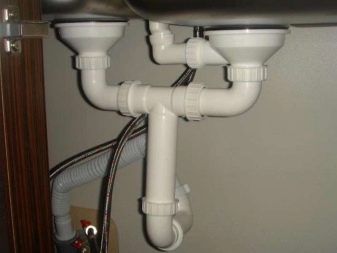

Other selection criteria are the diameter of the sewer and the number of drainage channels. In bathrooms, units with overflow are usually used. If the appliance is to serve the washing machine, it must have additional outlets. The same approach is practiced for servicing dishwashers. Sinks with two drains should be connected to siphons equipped with a pair of nozzles.
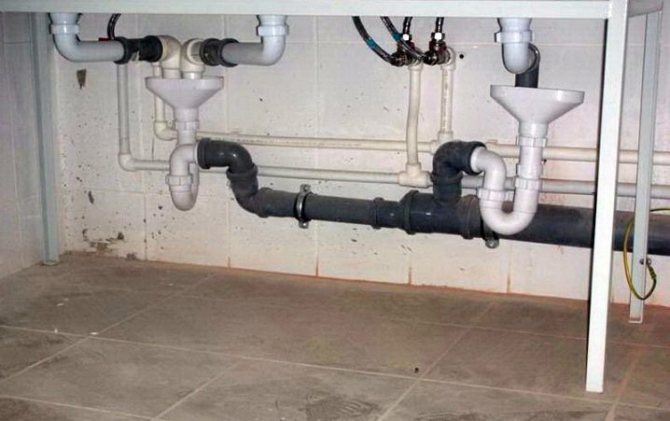

It is not recommended to use bottle cast iron siphons. This is an outdated option, now polymer modifications are already installed almost everywhere. Cast iron can only be used very rarely for a sewer element. The selection of a specific model is adjusted for the number of connected devices. The more there are, the higher the overall performance should be. The presence of a sump is good where there is a high risk of losing valuable things - most often these are sinks.
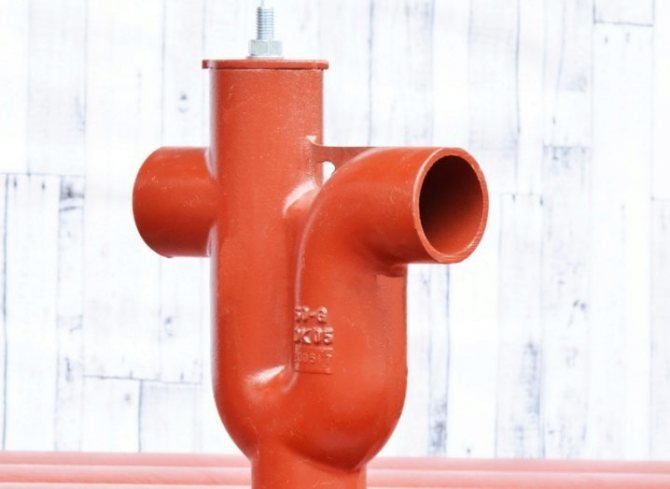

The advantage of the bottle design is that a longer service life can be guaranteed than with corrugated pipes.Smooth tubular elements are used only in isolated cases, because pipe bending is technically difficult, and the resulting structure requires a lot of space. The bottle odor trap from a corrugated pipe is universal in terms of characteristics, and can be assembled by hand. To connect to the toilet, corrugated pipes with a cross section of 11 cm are used. If necessary, adjusting the length of the loop is possible even on an installed and connected system.


Another advantage of the "bottle" is the ability to dismantle and then move sinks or toilet bowls over short distances without removing the siphons. The design of the drain is always more complex than that of other hydraulic valves. A similar element is mounted in shower trays or directly in floor coverings. The increasing complexity of the product is justified by its expanded functionality. The ladder, along with the containment of foreign odors and the drainage of liquid, maintains the tightness of the connection with the floor and becomes a kind of pre-filter.
For information on how to make a water seal for the sewage system with your own hands, see the next video.
Article Rating
Advantages and disadvantages of corrugated hydraulic valves
The corrugated type of siphon is presented by a polypropylene modification, which is distinguished by its strength, flexibility and the possibility of installation when arranging sewage systems in small-sized rooms. Due to its plasticity, such a pipe can be located in places where other types of siphon cannot be placed. This is the simplest option, which contains the minimum number of elements that do not need to be assembled.


The corrugated valve is the simplest option with the fewest elements
The corrugated siphon can be turned at any angle and directed to the desired direction. This version of a do-it-yourself sewer seal is often installed under the bathroom, since the model can easily fit in a cramped place between the floor and the bottom of the tank. One end of the water seal is connected to the drain hole, and the other to the sewer pipe. With the help of a corrugation, you can also organize a drain with a water seal in the bathhouse of a private house.
Despite the many advantages, the corrugated siphon has a single, but significant drawback. The surface of the pipe has ribbed walls on which debris such as hair, soap, sand and other dirt accumulates. When installing such a siphon, a fine-mesh filter should be installed.
Important! If the bellows are not cleaned for a long time, they may lose their strength and elasticity under the influence of excess weight in the form of dirt.
When operating a corrugated water seal, its condition should be monitored. Sagging causes debris to build up. The folds will start to wear out quickly, crack and leak water.
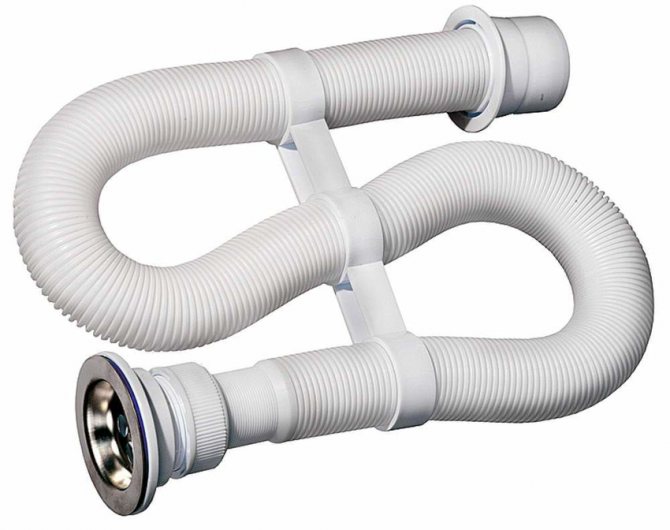

If the corrugated odor trap is not cleaned, it may lose its elasticity and strength.
Types of hydraulic sewerage valves
The classification of devices is made taking into account several factors, but the main ones are design features. Based on the technical nuances, there are six main types of hydraulic locks, we will dwell on each of them in more detail.
# 1: Knee Modification Features
The knee odor trap can be identified by its appearance - it resembles the letter U. The advantage of this type is its strength, which allows it to withstand the maximum pressure in the pipes. The throughput of the device depends on the cross-section of the pipe, which should not be less than the release of plumbing equipment.
The main places of the sewer system in which the installation of knee hydraulic locks is appropriate are the drain of the bathtub and toilet. Sometimes, instead of one, two siphons are connected.
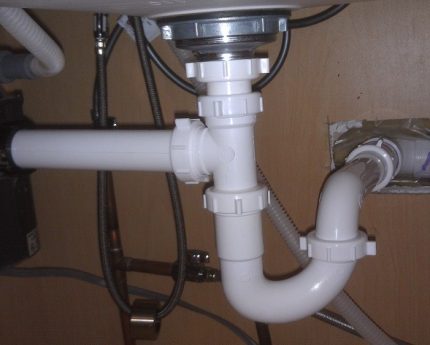

For the manufacture of knee devices, cast iron and even bronze were previously used, but now it is more expedient and cheaper to use modern material - polypropylene, which is lightweight, reliable and easy to install
There are different types of knee siphons. Some of them are a single plastic device that does not lend itself to adjustment. In the event of a breakdown, it must be dismantled entirely. Other devices consist of several parts, so if necessary, you can extend the length of the pipes and change their position in order to adjust the volume of water. The position of the pipes is fixed with overhead plastic clamps and nuts.
The knee has two bends - at the entrance and at the exit. The point of the second inflection should be slightly lower than the point of the first (by 5-6 cm). Sometimes an S-shaped structure is used for a more reliable lock, the principle of its operation is the same.
Knee structures are cleaned in two ways:
- by completely dismantling the device;
- special flexible cable.
Some polypropylene versions are equipped with an inlet for the drain hose of the washing machine or dishwasher.
# 2: Benefits of a Bottle Device
This type of water seal is popular in kitchens for equipping a drain system under sinks for dishes. When washing dishes and pans, some food waste enters the system, which is fraught with clogging.
The design of the bottle model retains food debris, which helps to maintain the performance of the sewage system. In addition, the bottle device retains its main purpose - to prevent the appearance of unpleasant odors in the home.
In addition to pipes, which form the basis of any water seal, this type is equipped with an additional element - a "bottle". This is a kind of container for collecting food waste. The sump is located below the level of the drain pipe, so it is easy to get to it if necessary.
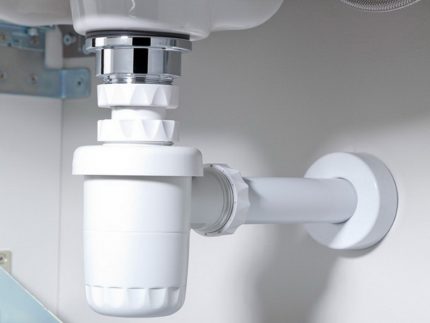

The connection of the two parts of the bottle model is made in the following way: first, the vertical pipe enters the sump located below, then the horizontal branch pipe exits from the side towards the sewer pipe
The bottle device is made of polypropylene, but in terms of strength it is considered weaker than the knee counterpart. The fact is that unreliable connections cannot withstand the strong pressure of water, therefore this type is used exclusively in the kitchen and is absolutely not suitable for equipping a toilet or bathroom.
A blockage in a water seal occurs when a dense mass of food residues completely clogs the sump and blocks the path of water. Thanks to the bottle configuration, clogging is very easy. It is enough to unscrew the overhead nut, which connects the sump, and shake out the accumulated debris from it. Then it is necessary to put the "bottle" in place and tighten the nut more tightly, otherwise water leakage is possible.
Bottle designs are also useful in terms of preserving items that accidentally fall into the drain. Careless housewives often took out their rings from the sediment tanks, slipping from their fingers when washing dishes with soapy water.
# 3: Double-turn water seal device
The design of the double-turn water seal resembles that of a knee valve, but differs in a more complex configuration. The drain pipe is connected to the outlet of the plumbing fixture, and at the junction it is equipped with a filter grate to retain waste, hair and other debris.
Further, it smoothly passes into the elbow, which ends with a connection with another pipe. The last element is directed to the drain and is at a slight slope.
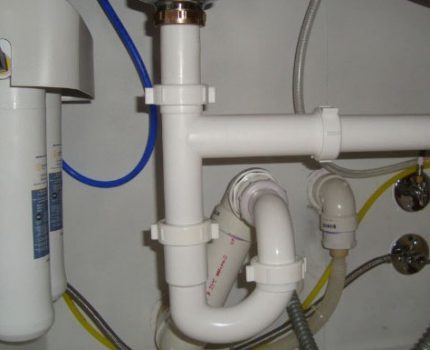

Some two-turn models are equipped with a pipe cleaning inspection port, which is tightly closed with a plug. The function of the hole is sometimes performed by a removable fragment of the knee. The hole is usually located at the lowest point and the removable part is at the top
Household double-turn structures were previously made of cast iron, now - from polypropylene. Cast iron counterparts can only be used in industrial plants with increased volumes of effluents and high pressure in pipes. Chrome parts look more presentable, which are close to polypropylene in technical characteristics.
If we compare this model with the bottle alternative, then the second option is easier to maintain. However, the two-turn device is more reliable in terms of leakage protection and, thanks to its simple, adjustable design, can be installed even in tight spaces.
# 4: corrugated model - pros and cons
Among the propylene modifications, there are also corrugated models - durable, flexible, sometimes simply necessary for arranging a sewer system in small rooms. Due to the plasticity of the pipe, the corrugation is placed in places where it is difficult to place other types of structures.
It can be rotated at the desired angle and directed in any direction, while the firmly fixed plastic has only a few position options.


A corrugated odor trap is often placed under the bath, since less flexible models do not fit in the narrow space between the bottom of the tank and the floor. One end is connected to the drain hole, the other to the outlet into the sewer pipe
However, when choosing a corrugated option, it is worth knowing about its only but significant drawback. The ribbed walls of the pipe seem to be designed to collect debris: food debris, hair, bits of soap, sand and other dirt get stuck in them. Considering this, when installing the corrugation, the drain must be equipped with a filter in the form of a fine-mesh grate.
If the corrugated odor trap is not cleaned for a long time, it loses its strength and elasticity under the influence of dirt and excess weight. Over time, the folds wear out, begin to crack and allow water to pass through. Having installed a flexible siphon, be sure to monitor its condition and clean it in a timely manner. You can guess about the contamination of the pipe by the sags that form in places where fat and debris accumulate.
# 5: How Overflow Works
Another type of siphon - with an overflow - can also be distinguished into a separate category, since it is necessarily equipped with an additional pipe. The main purpose of the overflow equipment is to protect the apartment from flooding if, for some reason, when the tap is open, the water stops going down the drain.
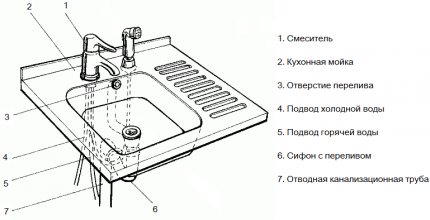

The sinks on which this device is installed have an additional hole - in the upper part of the bowl, under the mixer. When the level of water accumulated in the sink reaches a critical level, the liquid begins to flow into this hole and further, into the water seal (+)
Baths must be equipped with an overflow system. This method prevents flooding, but unfortunately does not contribute to savings. If you want to take a bath and forget to turn off the tap on time, the water, having reached the overflow level, will safely leave the container and go down the drain - along with your utility bills.
On the market, they are presented as economical plastic options, as well as more durable, but less elastic metal models. The disadvantages of brass-bronze equipment are the complexity of installation and high cost. When choosing a device, do not forget to inquire about its bandwidth. If an overflow cannot handle the excess fluid, it is useless and even dangerous.
# 6: dry seal design
The design of the so-called "dry" valve is fundamentally different from its hydraulic counterparts.It works on the principle of "nipple" operation and is a threaded pipe, inside which a check valve is installed. As a result, the water entering the inside of the device cannot flow back, just like the smell has no chance to leave the pipe.
The installation of such devices is justified on the lower floors of multi-storey buildings, as well as in places where water is used less often (in baths).
Dry locks are fundamentally not installed in kitchen sinks, the use of which maximally provokes the creation of blockages. But the devices work efficiently and serve for a long time in self-built shower cabins.


The "dry" type valve does not need a constant presence of water inside the body. Even if it functions in conjunction with a knee device, it does not need to be monitored or adjusted.
There are several types of dry devices:
- membrane, overlapping after draining the water with an elastic membrane;
- pendulum, tending to instant closure if no liquid is supplied;
- float, closing the hole when water leaves the drain (acting like a drain tank valve).
The latter are often made independently, equipping the sewer wiring in the baths.
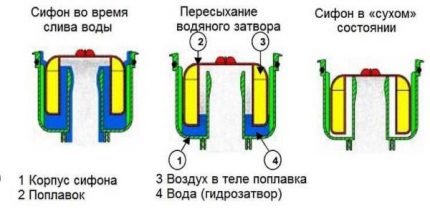

The simplest is the principle of operation of a float valve. The light weight keeps the float on the surface of the water. As soon as it drains, the float goes down and blocks the drain.
If the sewer lines suddenly dry out due to rare use, thanks to the dry shutter, the unpleasant smell will not bother you.
Characteristics of the overflow system
Another type of product is a hydraulic siphon with a water seal for a sink or sink, equipped with an overflow system. The device is equipped with an additional pipe, which eliminates the likelihood of flooding the apartment if it is impossible to drain water into the sewer. This branch pipe is inserted into a specially created hole for it, which is located at the top of the sink or sink.
This siphon prevents flooding, but increases water consumption. If the tap is turned on and the drain is closed, when a certain level is reached, water will flow through the overflow pipe into the sewer. The odor trap with overflow system can be installed in the kitchen or bathroom.
Hydraulic valves with an overflow system are made of plastic or metal. Plastic products have a lower cost and are highly elastic. Brass-bronze siphons are characterized by strength, durability, complexity of installation and high cost.
Important! When choosing a siphon with an overflow, you should pay attention to the throughput of the pipe so that the device will work efficiently in the future.
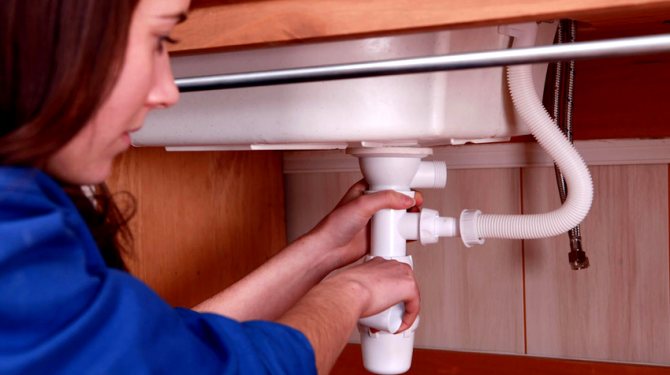

The odor trap for the sink or sink is equipped with an overflow system - an additional pipe, thanks to which the possibility of flooding the apartment is excluded
What is a dry siphon for sewage
The principle of operation and design of a dry water seal for sewage differ from previous analogues. A non-return valve is installed in the threaded drain pipe, which prevents the return flow of water and the entry of unpleasant odors from the sewer system into the room.
Important! It is advisable to install such water locks exclusively in shower stalls, and in kitchen sinks, they can cause permanent blockages.
The dry odor trap for the shower stall is presented in several varieties. In the membrane version, the opening is closed at the moment of the outflow of the liquid by means of an elastic silicone membrane in the form of a short sleeve. Pendulum siphons, thanks to the curtains, provide quick blocking of access to the hole.
Float models work on the principle of a flush tank.The design is an inverted lightweight glass with the edges immersed in water. The light float is positioned on the surface of the water. After draining it, going down, it blocks the drain. In some models, instead of a float, a light ball is installed, which, after the liquid has flowed out, falls into the outer seat, ensuring a tight closure of the drain hole. This option can be made independently when arranging sewer wiring in a bath.
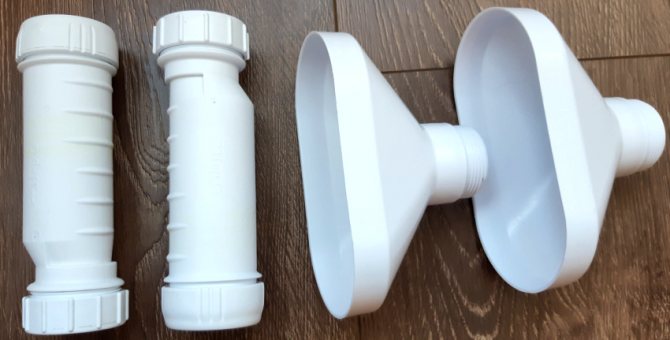

It is advisable to install a dry siphon for sewerage only in shower stalls
Important! In the event that the sewer lines dry out during the period when they are not in use, the dry seal will prevent an unpleasant odor from entering the room.
Waste water trap with dry seal
Dry seals are used when the drain is rarely used, as a result of which the water in this place dries up. The dry device is installed separately or in parallel with a conventional odor trap.
At home, a dry odor trap can be organized using a tennis ball. Of course, this option is suitable if the diameter of the ball is capable of blocking the entrance to the sewer tube.
When equipping a water seal, it must be remembered that its action is based on the operation of the membrane, which is fastened with a spring. This spiral fixes the float only when the water is completely dry. If water flows constantly, the spring cannot fix the float for a very long time. Then it is most expedient to establish a pendulum system, the essence of which is in the gravitational properties of objects and ensuring a change in the center of gravity.
Arrangement of a water seal with your own hands:
- Find a light ball that fits the pipe in diameter.
- Equip a camera at the entrance to the sewer pipe.
- Place the ball in the inlet.
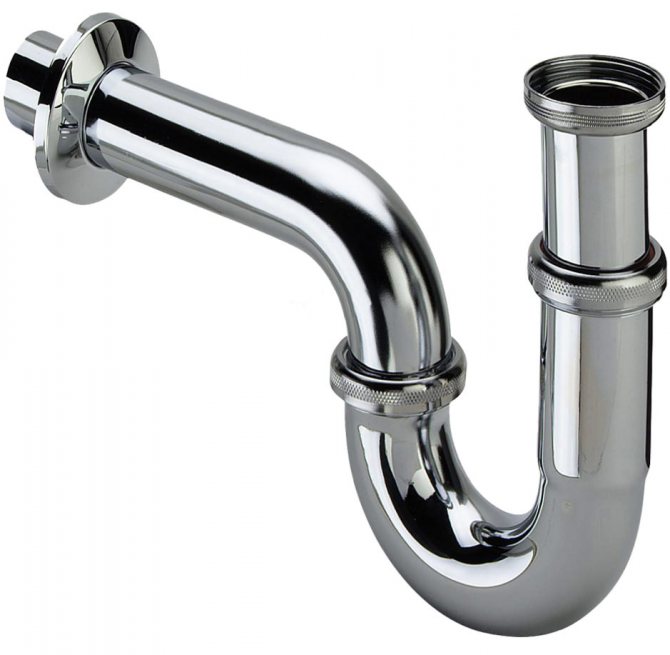

Dry seal siphon with excellent performance
When there is no water in the pipe, the ball lies on the surface, blocking the entrance. The moment water flows in, the ball floats up and the water enters the pipe unhindered. This method can be used not only in the bath, it is suitable wherever it is convenient.
Characteristic features of a sewer drain with a water seal
When draining is carried out from the entire surface of the floor, a sewer drain with a water seal is installed. It is installed in the central part of the floor with a slight slope at the time of construction of the shower stall.
The shower drain with a water seal consists of a receiving funnel, a siphon with a removable grid and a drain with a coupling. The first element is designed to receive water and discharge it into the sewer. It is securely attached to the floor surface.
The tightness of the connection is ensured by means of a waterproofing membrane. Further, the water enters the siphon, which is represented by a small-volume chamber, passing through the upper filter grate and the branch pipe. Then the drain, overflowing through the outlet openings or the edges of the container, moves along the outlet pipe connected to the sewer pipe.
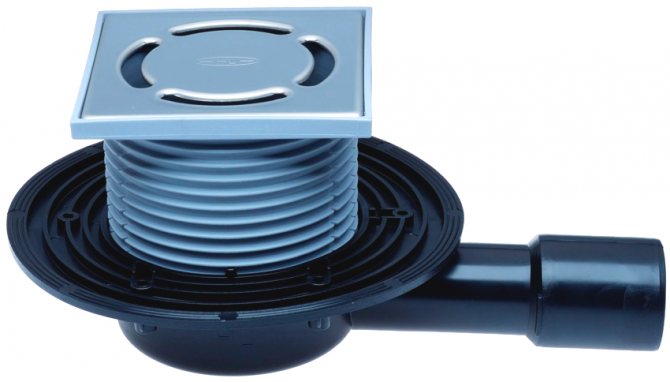

The sewer drain with a water seal consists of a siphon with a removable grate, a receiving funnel and a drain
In terms of design, such a mechanism resembles a bottle-type device. However, the siphon for the shower tray with a water seal does not have a removable bottom cover, which is used to remove debris. This is due to the fact that the siphon body is hidden in the floor screed. All debris is collected in the inner glass, which can be easily removed from the housing and cleaned with detergent.
Construction and material for the manufacture of a shower drain with a water seal
Sewer drains can be made of plastic or metal. Polymer odor trays for a shower in the floor do not corrode, are easy to install, are characterized by durability and low cost.Metal products can be made of cast iron or steel. The first option is characterized by high throughput and durability. However, due to its significant weight, it is laborious to install. Cast iron drains are suitable for swimming pools, toilets and laboratory rooms.
Stainless steel drains are lightweight, reliable, durable and easy to install. It is customary to install them in medical and research organizations, because the devices meet the requirements of sanitary standards. The receiving lattice can be in the form of a circle, square or rectangle.
The sewer drain with a dry odor trap has a horizontal or vertical design. The first option, whose height is 6-10 cm, is often used for an apartment or a private house. It is also installed in confined spaces.


Float models of sewer drains with a dry water seal work on the principle of a cistern
The vertical drain has a height of 15-18 cm, is characterized by a high flow capacity and is mainly used for shower stalls. A ladder with a drainage system with a diameter of 50 mm is installed in apartments and houses, and in public premises - a water seal for sewage 110 mm.
Varieties of sewer water locks
On the plumbing equipment market, you can purchase both a ready-made water seal for the sewage system, and various elements from which it is easy to assemble it yourself. The consumer usually uses two or three types of hydraulic locking units, the rest of the modifications are designed for operation in specific conditions.


Fig. 3 Knee siphons
Knee under the bath
In appearance, the knee models of hydraulic valves resemble the letter U, the unit is characterized by a simple structure and high strength. The main places for the installation of the U-shaped elbows are under the bathroom, in the toilet a similar water seal is built into the structure.
There are several types of elbow siphons, some models are designed for rigid and durable installation in the pipeline and have a design in the form of one elbow with union nuts, others consist of several parts that allow precise adjustment to the inlet and outlet pipes.
Knee siphons can be made small in height, unlike bottle siphons - this expands the scope of their application from sinks to installation under bathtubs with a lowered drain pipe. The disadvantages of the devices include inconvenience in maintenance - in order to remove dirt and debris that have settled to the bottom, you have to completely dismantle the device.
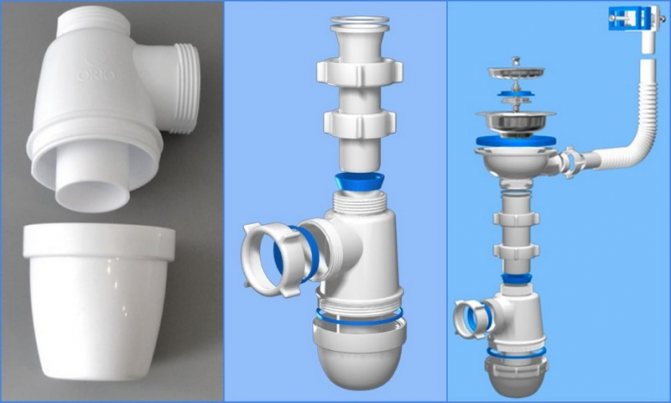

Fig. 4 Device for bottle siphons
Bottled sinks
Structurally, they are made in the form of a cylindrical body-settling tank with an upper and a side outlet, which has a twist-off lid at the bottom. During operation, water enters through the inlet into the volumetric flask, and after filling it, it pours out through the side outlet - the water seal provides the liquid remaining in the flask of the device. The design allows you to collect all the dirt from the sinks at the bottom of the flask and periodically remove debris by unscrewing the lower cap, if heavy objects have fallen into the sink, it is easiest to get them out of the bottle body.
Due to the ease of maintenance, bottle siphons are installed under kitchen sinks, washstands in bathrooms, where there is enough space under the sinks to accommodate their rather voluminous and vertically elongated body. The disadvantages of siphons of this design include the impossibility of cleaning the sewer pipeline with a plumbing cable through their body - the device must be dismantled, freeing the pipeline, after which the necessary work is carried out.


Fig. 5 Varieties of siphon corrugations
Corrugated S-shaped
One of the simplest and most versatile options for organizing a water seal is the use of a piece of flexible corrugated pipe, which is bent in the shape of the letter U, like a knee. When the corrugation outlet is lowered down, an S-shape appears.
The corrugation is good for its versatility - the bend can be made in any convenient place, it is easy to connect it to the drain hole and the sewer pipe at any of their relative position and distance due to the ability of the corrugated shell to stretch and easily change its direction. A plastic holder is included to keep the shape unchanged.
The main disadvantage of a corrugated hydraulic seal is a high hydraulic resistance to water flow and a ribbed inner shell, in the grooves of which dirt accumulates intensively.
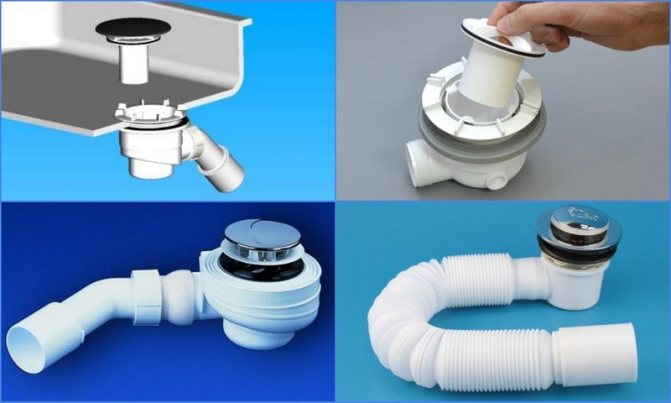

Fig. 6 Overflow siphons for shower bowls - design
Overflow for shower cabins
A distinctive feature of all shower cabins is a rather small distance of the drain hole of a special design from the floor - this imposes certain requirements on the siphon unit. Structurally, many siphons for shower cabins are made in the form of a low cylindrical body, into which a removable glass is lowered. Water enters the glass through a branch pipe with a lid lowered into it, and after filling it overflows through its walls, which have side holes or the height of the upper edge below the siphon body.
If any debris or small valuable objects get into the shower tray, they can be easily removed by removing the cover together with the inlet pipe and pulling the glass containing the objects out of the siphon unit. The designs of overflow shower siphons are quite diverse, they are all united by a round chrome cover, which provides side drainage and which is easy to stand on, as well as a low body.


Fig. 7 Parts of the shower overflow trap
Bath ladders
In baths, steam rooms and saunas with a shower, in places where storm drains accumulate, water is collected from a large area, therefore, to supply it to the drain point, the floor is made with a slope, and a ladder is placed in the center. The standard device is a small-volume chamber, into which water enters through the upper grate and the nozzle, after which it overflows through its edges or upper outlets and then follows the pipe.
The design is in many ways similar to bottle-type siphons, but it does not have a lower removable cover for removing garbage, since the body of the device is placed (walled up) in a screed. The dirt is usually collected in an internal glass, which can be easily removed from the body of the device.
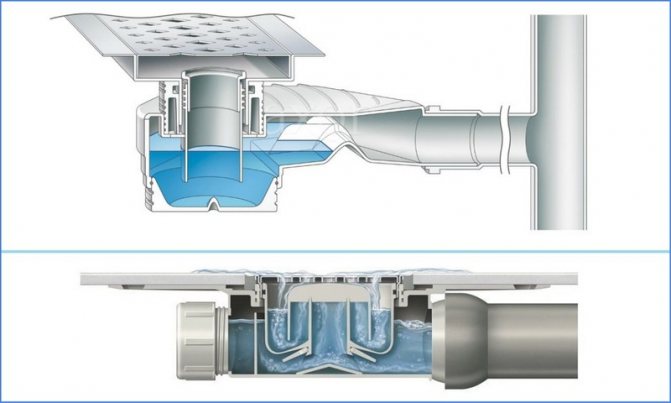

Fig. 8 The principle of operation of trap water traps
How to choose the right water seal for the sewage system
When choosing a water seal for the sewage system, the price of which is in the range of 300-600 rubles, the following factors should be taken into account:
- dimensions of the assembled siphon;
- features of this type of device;
- material for the manufacture of pipes and fasteners;
- number of drains and possible additional connections;
- the level of protection against blockages;
- the presence or absence of overflow.
The shutter type is selected based on the installation location. For the kitchen sink, the best solution would be a bottle design equipped with a container for collecting food waste. For a bath, it is most convenient to mount a corrugated siphon, which can be located even in the most cramped conditions.
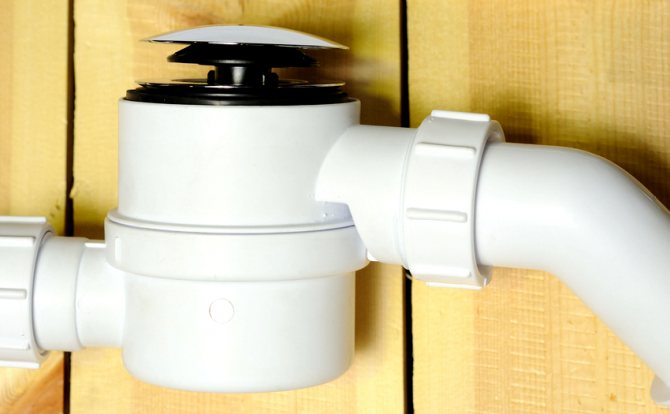

If the shower siphon will be used infrequently, it is recommended to install a dry odor trap.
The version of the shower siphon is selected taking into account the frequency of its use. If it will be used rarely, a dry odor seal for a bath or shower should be installed, which, even when the water dries, will not let foreign odors into the room.
The number of inlets in the siphon must correspond to the number of drains for which the given odor trap is intended.An important criterion is the diameter of the throat of the device. For the sink and washbasin, it can be the smallest, and for the toilet - the largest. The diameter of the outlet pipe is also taken into account when connected to a sewer pipe. For sinks and washbasins, a 50 mm water seal is sufficient. For a toilet bowl, this parameter should be at least 100 mm.
Material for the manufacture of a hydraulic seal
The reliability and durability of the device depend on the material of manufacture. Traditionally, steam locks for baths, baths and kitchens were made of cast iron, due to which they were characterized by strength, resistance to aggressive environments and a long service life. The disadvantages of products include the presence of an internal rough surface, which tends to retain various contaminants. It is ideal for industrial construction.
Most modern models of hydraulic locks are made of polypropylene, as a result of which they have a low cost. The devices are characterized by strength, reliability, chemical inertness, lack of tendency to accumulate contaminants in the cavity (due to the smooth inner surface).
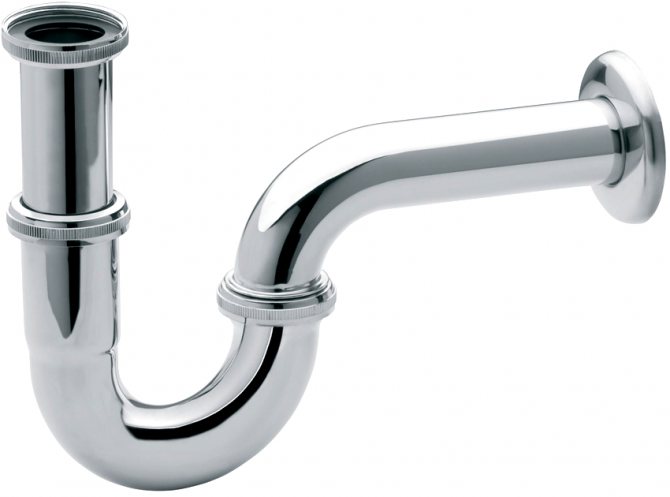

Premium siphons are available in brass or bronze and nickel plated
Premium dry odor traps are made of brass or bronze with a nickel plated finish, which gives the products an aesthetic appearance. Such valves are characterized by a long period of reliable operation. Stainless steel siphons are in demand in hospitals and children's institutions. Such devices are well cleaned and disinfected, which does not affect their durability.
What material to prefer a water seal
The material from which the structure is made affects the strength and durability of the device. Previously, all devices were made of cast iron, which is characterized by increased strength, withstands the aggressive environment of runoff water. The downside is the rough surface inside the pipe, on which mud residues adhere. Cast iron products are installed in industrial sewers.
Modern models are made of high strength plastic materials. They are lightweight, cheap, durable, able to transport any kind of liquid, and have a smooth inner surface.
Elite dry-type devices are made using bronze, brass, which are nickel-plated. The constructions have a presentable appearance and are reliable in use. Water locks for kindergartens, schools, hospitals are made of stainless steel, as they are easy to clean and disinfect without fear of reducing the service life.
Diy installation sequence of a water seal for sewage
Installing a water seal for a sewage system in a bath, bathroom or kitchen is a simple undertaking that you can do yourself without having certain skills. Under the washbasin or sink, the installation process is quite simple, and under the bathtub it is more laborious, due to the inconvenient location of the drain system.
Important! Any type of siphon can be purchased complete with all the components at a plumbing store.
Consider installing a do-it-yourself water seal for a 110 mm bottle-type sewage system. The set includes a siphon, a corrugated pipe, overflow design elements and fasteners. The first step is to equip an overflow hole. For this, an elastic gasket is inserted into it, which is fixed with a silicone sealant. Then a chrome-plated decorative element with a rod is screwed on, on which a lamb is attached.


After installing the water seal, you must remember to connect it to the sewer pipe
At the next stage, fittings are installed to decorate the drain hole in the bathtub, sink or washbasin.A long fixing screw is screwed into it, which fixes the siphon. First, it is twisted by hand, then clamped with a key. A rubber gasket is put on the plastic outlet. Next, insert the knee bolt. Finally, tighten the plastic outer nut. The odor trap is connected to the sewer pipe by means of a polypropylene pipe.
After the installation is complete, the system is tested. For this, the device is filled with water. All elements of the system are inspected for leaks.
How to mount a sewer drain with a water seal
Installing a sewer drain with a dry water seal is a very responsible and time-consuming process. The correctness of the work performance directly determines the level of its high-quality and durable operation.
At the first stage, the floor in the shower or bath room is lifted, which should have a slight slope towards the ladder, which will contribute to the spontaneous drainage of water from the horizontal surface.


The sewer drain is installed according to the instructions - thermal insulation, waterproofing, cement screed and floor tiles are laid on the floor
The sewer drain is installed according to the instructions that come with the device. Heat-insulating material is laid on the surface of the floor, at the same time acting as sound insulation, which contributes to the quiet drainage of water from the plumbing fixture into the sewer system. Styrofoam is suitable for this. Then a layer of waterproofing is laid. For this, you can use a roll material with a membrane structure or a coating mixture.
Next, a cement screed is made, the thickness of which is selected taking into account the height of the ladder and the thickness of the tile. Floor tiles are laid on top with an adhesive solution.
Important! The water seal grill must be flush with the tiles.
DIY installation of a ladder in the shower under the tiles
When installing a shower drain during the construction of a private house, usually there are no questions about how to make a drain in the floor of the shower stall. In this case, the ladder is installed in the floor screed, which is then tiled, and a vertical drainage of the sewage pipe is made into the sewer canal.
With the arrangement of the drain in the apartment, things are somewhat different. In the bathrooms of apartment buildings, most often, the thickness of the screed is not enough to arrange a vertical ladder in the shower. Therefore, to equip the booth with this product, first raise the floor level in the room, while ensuring its slope. As a rule, a height of 12-15 cm is enough to place a siphon and a drain pipe under the screed.
Install a ladder in the shower floor with their own hands, observing the following sequence:
- First, using a tape measure, the location of the ladder is measured out with the expectation that a multiple number of tiles should fit from the drain to the walls, not forgetting about the tile joints (1.5-2 mm). This will make the floor look more aesthetically pleasing than with cut tiles.
- Then the ladder is connected to the sewer by means of pipes. The slope of the drain pipe must be at least 3 cm per linear meter.
- If it is necessary to insulate the screed, use foam sheets with a thickness of 5 cm and a density of at least 35 kg / cu. meter, but it is better to use extruded polystyrene foam, as it is harder and less exposed to a humid environment.
- Insulation sheets are laid on the rough surface of the floor and adjusted to the dimensions of the plumbing ladder, and a concrete screed is made on top with a layer of about 4 cm, which should fill the entire space up to the drain flange.
- Allow the screed to dry until it hardens completely.
- Then, a gasket for the flange must be made from the waterproofing material, which should overlap the flange with a margin.A hole must be cut inside the gasket, according to the inner diameter of the flange.
- The upper part of the flange must be placed on the gasket and screwed to the lower part of the structure.
- After that, the screed must also be covered with a roll-on waterproofing agent. The laid material should overlap the flange gasket and extend onto the walls by a few 3-5 cm.
- Next, into the body of the shower drain, you need to insert its inner part with a siphon.
- Then you need to fill in the finishing screed with a slope of about 10 mm per meter of filling. To do this, guide plastic slats are placed on the surface of the floor with a waterproofer, beveling them towards the drain. You can buy ready-made systems for making shower drains.
- The pouring of the second layer of the screed must be below the height of the siphon so that it can be level with the tiles. Do not remove the guide rails from the screed. At the same time, so that the solution does not get into the drain and onto the walls, it is recommended to seal the ladder grill with tape, and the corner between the floor and walls with waterproofing tape.
- Next, the surface is tiled, starting from the drain hole to the walls. The tiles should be flush with the grate of the ladder or by a few 3-5 mm. higher.
- After the tile adhesive has dried, wipe the joints with a waterproof material matched to the color of the ceramic tile.
- The areas where the tiles are in contact with the body of the drain must be carefully and carefully sealed with silicone sealant.
- At the end of all work, a protective grid is mounted on the shower drain body and fixed.
A properly installed shower drain will make taking water procedures more comfortable, giving the bathroom an original look.
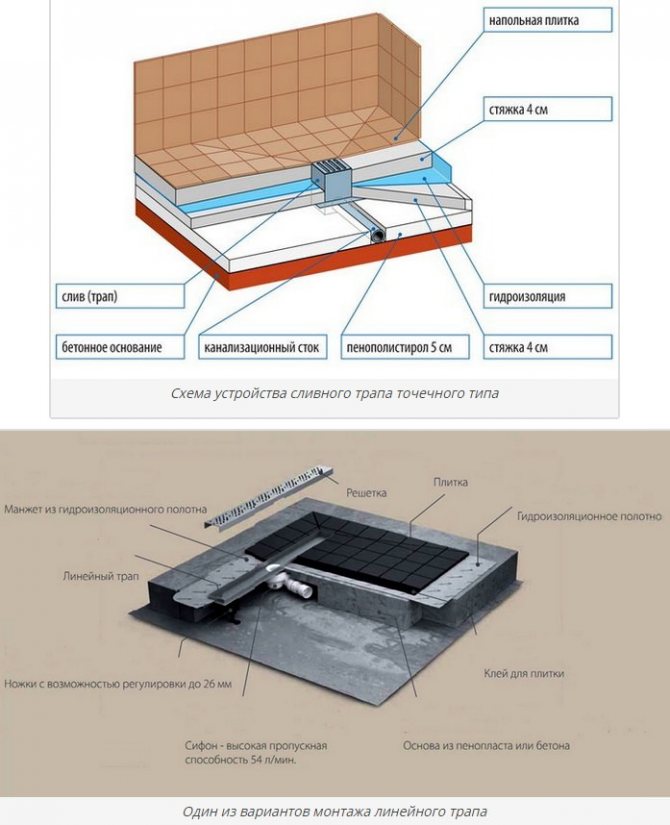

Possible reasons for the violation of the correct operation of the water seal
The hydraulic valve is a simple product in terms of design, which consists of a minimum number of uncomplicated elements. Therefore, the failure of the siphon is extremely rare. In this case, situations may arise that negatively affect its normal functioning.


Failure to comply with slopes and a violation of the sequence of assembly of the hydraulic seal can negatively affect its operation.
A device malfunction can occur as a result of a sharp drop in pressure in the pipes, malfunction of the sewer network, depressurization of drain pipes, which is possible as a result of mechanical damage or improper connection.
If a riser is clogged in a multi-storey building on the upper floors, when large volumes of water are drained, a vacuum is formed in the pipe, as a result of which water is attracted from the water seal. This causes unpleasant odors to appear. In this case, the question arises of how to eliminate the airlock in the sewer. You can eliminate the problem by cleaning the riser or installing a vacuum valve at its end. Dry valves often begin to malfunction as a result of clogging of the descending float or closing diaphragm.
Incorrect installation will also negatively affect the operation of the device. The reason may lie in non-observance of slopes, violation of the sequence of assembly of system elements, spontaneous straightening of the corrugation.
Important! If the siphon is rather old, it may no longer cope with its main function of protecting the room from the penetration of unpleasant odors. In this case, you will need to disinfect the well with a water seal or replace the device with a new element.
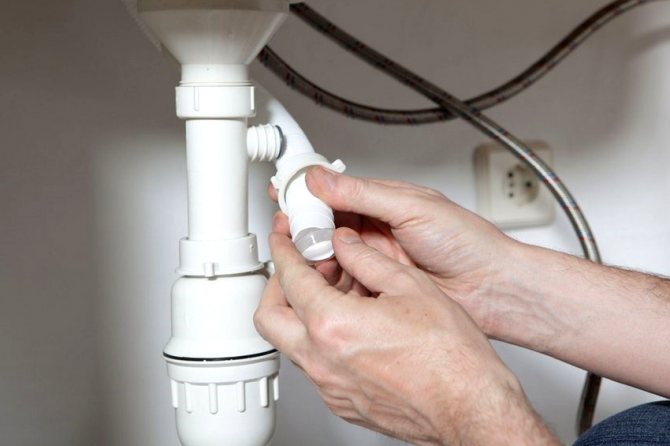

If the siphon is old, it may not cope with its task, it is necessary to replace the water seal with a new one
If there is a sewage odor in the room, it is necessary to check the functionality of the water seal. You should pay attention to the water level in the toilet, which should be the same for every flush. In the bathroom and kitchen, the check can be done with a flame. For this, a match is brought as close to the sink as possible.The absence of a flame will indicate normal operation of the device.
If the flame ripples, you should turn on the water for a minute, and then check the operation of the device again with a flame. If it still wobbles, the siphon is faulty.
Features of the choice of a water seal
The most important thing when choosing is to purchase and install a water seal that matches the purpose of the device. That is, they put bottles-based appliances in the kitchen, U-shaped under the bathtub, in shower cabins - corresponding low-height products, in floor screeds - ladders specially designed for these purposes.
When choosing a suitable model, they are additionally guided by the following considerations:
- In no situation should a corrugated odor trap be installed in the kitchen, despite the convenience of connection - dirt will always accumulate on its walls, which prevents drainage. This will lead to the need for frequent sewer cleaning, spending financial resources on the purchase of various chemicals or a plumbing cable for cleaning work, the price of which is much higher than the difference in cost between a cheap corrugation and a conventional siphon.
- Before buying siphons for a bath, you should be especially careful - not every model is suitable for installation under a bowl in its vertical dimensions. Therefore, you should first measure the distance from the drain to the floor, and then select the desired modification. This also applies to the selection of shower siphons if they are not included in the scope of delivery.
- When a water seal often breaks off in the system (a situation can arise in an apartment or private house if the sewer riser is clogged from above), they acquire a kitchen siphon with a built-in vacuum valve.
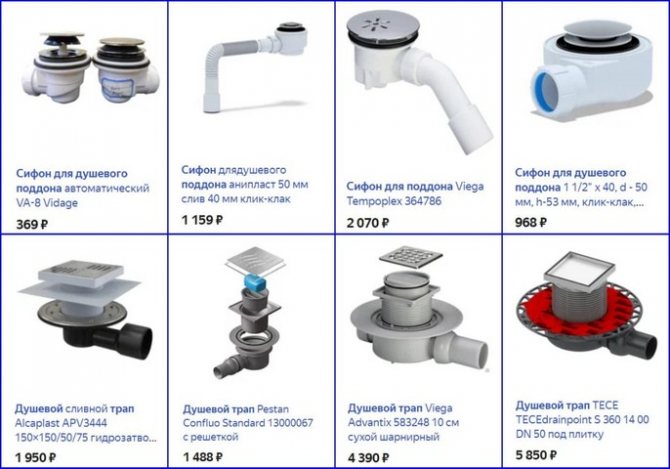

Fig. 12 Siphons for shower cabins and drains - prices
